Related Research Articles

Lychee is the sole member of the genus Litchi in the soapberry family, Sapindaceae.
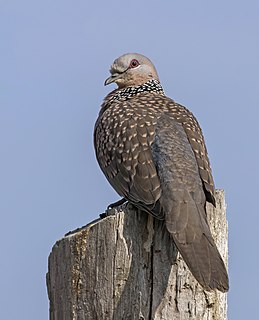
The spotted dove is a small and somewhat long-tailed pigeon that is a common resident breeding bird across its native range on the Indian subcontinent and in Southeast Asia. The species has been introduced to many parts of the world and feral populations have become established.
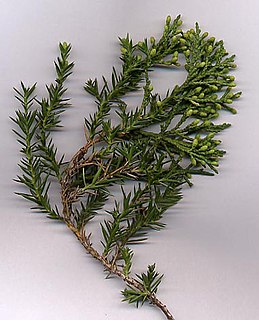
Juniperus chinensis, the Chinese juniper is a species of plant in the cypress family Cupressaceae, native to China, Taiwan, Myanmar, Japan, Korea and the Russian Far East. Growing 1–20 m (3.3–65.6 ft) tall, it is a very variable coniferous evergreen tree or shrub,

Schisandra chinensis, whose fruit is called magnolia berry or five-flavor-fruit, is a vine plant native to forests of Northern China and the Russian Far East and Korea. Wild varieties of Schisandra chinensis are also found in Japan. It is hardy in USDA Zone 4. The fruits are red berries in dense clusters around 10 centimetres (3.9 in) long.
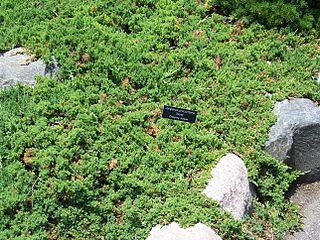
Juniperus procumbens is a species of shrub in the cypress family Cupressaceae, native to Japan. The status of this low-growing evergreen conifer as a wild plant is disputed. Some authorities treat it as endemic to high mountains on Kyūshū and a few other islands off southern Japan, while others consider it native to the coasts of southern Japan and also the southern and western coasts of Korea. It is closely related to the Chinese juniper, Juniperus chinensis, and is sometimes treated as a variety of it, as J. chinensis var. procumbens.
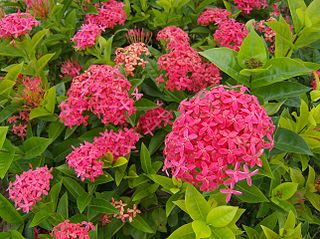
Ixora is a genus of flowering plants in the family Rubiaceae. It is the only genus in the tribe Ixoreae. It consists of tropical evergreen trees and shrubs and holds around 562 species. Though native to the tropical and subtropical areas throughout the world, its centre of diversity is in Tropical Asia. Ixora also grows commonly in subtropical climates in the United States, such as Florida where it is commonly known as West Indian jasmine. Other common names include viruchi, rangan, kheme, ponna, chann tanea, techi, pan, siantan, jarum-jarum/jejarum, jungle flame, jungle geranium, and cruz de Malta, among others. The plants possess leathery leaves, ranging from 3 to 6 inches in length, and produce large clusters of tiny flowers in the summer. Members of Ixora prefer acidic soil, and are suitable choices for bonsai. It is also a popular choice for hedges in parts of South East Asia. In tropical climates they flower year round and are commonly used in Hindu worship, as well as in ayurveda and Indian folk medicine.
Pratt's vole is a species of rodent in the family Cricetidae. It is endemic to Mount Emei, Sichuan, China. It was named in 1891 for Antwerp Edgar Pratt.
Eothenomys is a genus of rodent in the family Cricetidae. It contains the following species:
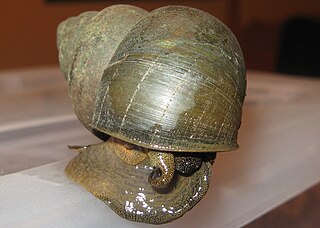
The Chinese mystery snail, black snail, or trapdoor snail, is a large freshwater snail with gills and an operculum, an aquatic gastropod mollusk in the family Viviparidae. The Japanese variety of this species is black and usually a dark green, moss-like alga covers the shell.
The Chinese water snake, Chinese smooth water snake, Chinese mud snake or Chinese rice paddy snake is a species of mildly venomous, rear-fanged snake, endemic to Asia.
Parasiccia is a genus of moths in the subfamily Arctiinae.

Calyptraea chinensis, common name the Chinese hat snail or Chinese hat shell, is a species of small sea snail, a marine gastropod mollusk in the family Calyptraeidae, the slipper snails or slipper limpets, cup-and-saucer snails, and Chinese hat snails.

Rhus chinensis, the Chinese sumac, or nutgall tree, is a plant species in the genus Rhus.

Linnaea chinensis, synonyms Abelia chinensis and Abelia rupestris, is a species of flowering plant in the honeysuckle family Caprifoliaceae. It was described by Robert Brown in 1818, and transferred to the genus Linnaea in 1872, although this move was not widely accepted until 2013. The plant inhabits China, Taiwan and Japan. It is a compact deciduous shrub with reddish stems and glossy, small leaves that become reddish-brown before autumn. It is one of the most cold-resistant species within the genus.

Parasiccia fuscipennis is a moth of the subfamily Arctiinae. It was described by George Hampson in 1914. It is found in Taiwan.
Parasiccia nebulosa is a moth of the subfamily Arctiinae. It was described by Wileman in 1914. It is found in Taiwan.
Parasiccia nocturna is a moth of the subfamily Arctiinae. It was described by George Hampson in 1900. It is found in Assam, India.
Parasiccia perirrorata is a moth of the subfamily Arctiinae. It was described by George Hampson in 1903. It is found in China.
Parasiccia punctilinea is a moth of the subfamily Arctiinae. It was described by Wileman in 1911. It is found in Taiwan.
Parasiccia shirakii is a moth of the subfamily Arctiinae. It was described by Shōnen Matsumura in 1930. It is found in Taiwan.
References
- ↑ Beccaloni, G.; Scoble, M.; Kitching, I.; Simonsen, T.; Robinson, G.; Pitkin, B.; Hine, A.; Lyal, C., eds. (2003). "Parasiccia chinensis". The Global Lepidoptera Names Index . Natural History Museum . Retrieved May 12, 2018.
| This Lithosiini-related article is a stub. You can help Wikipedia by expanding it. |